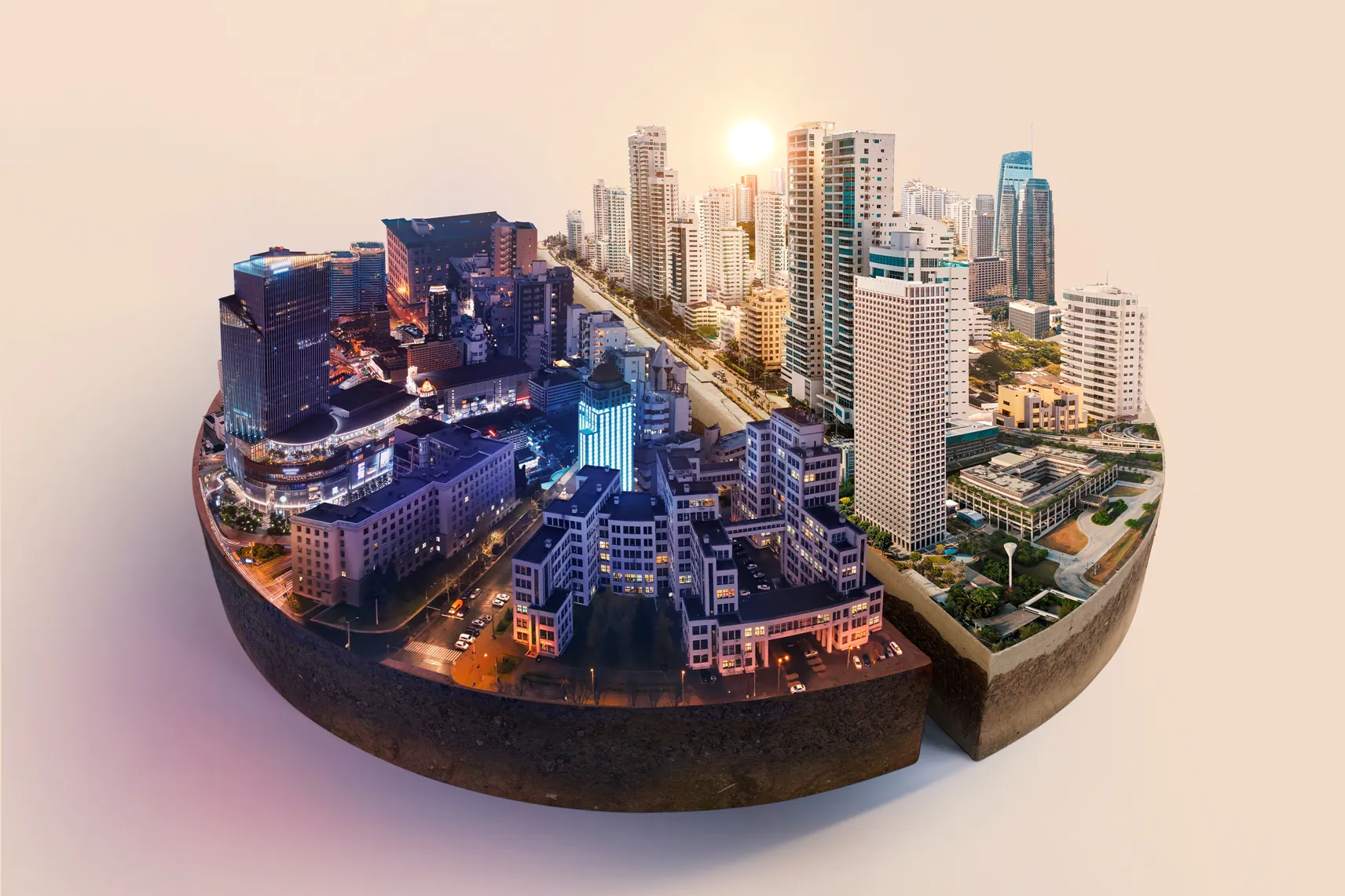What is a Smart City?
Can innovation and technology be used to redefine urban living? The answer can be found in a smart city.
As the world becomes increasingly interconnected, cities are transforming into dynamic ecosystems that leverage cutting-edge solutions to overcome the challenges of the modern world. But what is a smart city, exactly? How can it revolutionize the way people live and interact with urban environments?
What is a smart city?
A smart city is a municipality that uses information and communication technology (ICT) as well as Internet of Things (IoT) devices, and other modern technologies to optimize urban living.
The goal of smart cities is to improve operational efficiency, collect and analyze data, and improve the quality of living and resident welfare. A smart city leverages various technologies to optimize various aspects of city living, such as transportation, energy usage, healthcare, public safety, and overall urban management.
Some of the key features of a smart city include smart infrastructure, smart technologies, data-driven governance, smart mobility and transportation, sustainable practices and solutions, priority on public safety, and an improvement in quality of life.
It’s also important to note that the concept of a smart city is continually evolving as technology advances. Various cities around the world are starting to incorporate smart city initiatives to address the challenges and opportunities associated with urbanization and modern living.
Some examples of cities that have incorporated smart technology to solve problems and improve their way of life include Paris, London, Copenhagen, and New York City.
How does a smart city work?
A smart city works through the integration of various technologies and data-driven solutions. They enhance efficiency, sustainability, and the overall quality of life for its residents. The functioning of a smart city involves the following key steps and elements:
Function and Data Collection
- Smart Infrastructure: The city's infrastructure is enhanced with smart technologies to improve efficiency and sustainability. For example, smart grids help optimize energy distribution, intelligent transportation systems manage traffic flow, and smart buildings use automation to regulate energy usage.
- Internet of Things (IoT): The Internet of Things plays a crucial role in smart cities, connecting a wide range of devices and sensors to the Internet. This connectivity allows for real-time monitoring and control of various systems, from traffic lights to waste management.
- Sensors and Data: Smart cities rely on a network of sensors, cameras, and other data collection devices to gather information from the urban environment and daily life. These sensors can be embedded in infrastructure, public spaces, and even the personal devices of residents.
- Communication Networks: Robust communication networks, such as high-speed internet and wireless connectivity, enable the seamless transfer of data between devices and central management systems. This allows for real-time data monitoring and analysis.
- E-Government Services: Smart cities implement digital services and platforms to facilitate interaction between citizens and the government. This includes online portals or websites for accessing information, making payments, and participating in decision-making processes.
Analysis
- Data Management and Analytics: Collected data is processed and analyzed using advanced analytics tools. This data management and analytics process provides valuable insights into various aspects of urban life. This includes traffic patterns, energy consumption, air quality, demographics, preferences, etc.
Communication and Decision-Making
- Decision-Making Systems: The insights gained from data analytics are then communicated to city officials and administrators for informed decision-making. This can include optimizing traffic flow, resource allocation, emergency response planning, and other aspects of urban governance and living.
Action and Improvement
- Smart Mobility: Transportation systems are optimized through the use of smart technologies. This includes real-time traffic management, intelligent public transit systems, and the promotion of alternative and sustainable modes of transportation, such as electric vehicles.
- Citizen Engagement: Citizens are actively engaged in the smart city ecosystem through digital platforms. These platforms enable residents to provide feedback, report issues, and participate in decision-making processes, fostering a sense of community and collaboration.
- Sustainable Practices: Smart cities prioritize sustainability by incorporating green technologies and practices. This may involve the use of renewable energy sources, energy-efficient buildings, waste reduction strategies, and initiatives to improve air and water quality.
- Security and Privacy Measures: Smart cities implement robust security measures to protect the privacy and data of residents. This includes encryption, secure communication protocols, and policies to ensure the responsible and ethical use of data.
What structures does a smart city have?
A smart city incorporates various infrastructure and public utility services, leveraging technology and data-driven solutions to enhance efficiency, sustainability, and the overall well-being of its residents. Here are some key infrastructures and public utility services commonly found in smart cities:
Smart Lighting Technologies
Smart cities implement smart lighting and other modern lighting technologies like the ones by the SOLUM Group. They can also be found on the streets and in individual buildings or residences. They can incorporate solar street lights that harness the power of the sun to illuminate the streets and reduce energy consumption. Smart street lights are also a popular option for smart cities because of their efficiency and sustainability.
Smart Transportation
Intelligent transportation systems that include real-time traffic monitoring, smart traffic lights, and connected vehicles are also part of smart cities. Public transportation systems with smart scheduling, ticketing, and route optimization are preferred. Bike-sharing programs can also be available for those who prefer sustainable transportation. Public or private electric vehicle charging stations can also be an option for those who have EVs as their transportation.
Smart Energy Grids
Smart cities can also make use of smart grids for efficient and sustainable energy distribution in all areas. Most of the time, they also rely on renewable energy sources such as solar and wind power. Energy-efficient buildings with smart lighting and heating and cooling systems can also be found in smart cities.
Digital Infrastructure
High-speed internet and widespread wireless connectivity are also common when it comes to smart cities. Connected infrastructure, including smart poles and sensors, is also used to monitor various parameters. All of these help in communicating and analyzing data for further improvement of urban living.
Waste Management Systems
A smart city also utilizes smart waste bins equipped with sensors to optimize waste collection routes for residents. Recycling initiatives and waste reduction programs are also being implemented to enhance waste management and sustainability further. They also usually have monitoring systems for landfill capacity and waste disposal efficiency.
Water Management Systems
Smart water meters monitor and optimize water consumption in smart cities as well. There are leak detection systems to reduce water wastage, and even water quality monitoring to ensure safe drinking water. All of these help monitor and manage water for all residents and establishments in the smart city.
Public Safety and Security Devices and Systems
Smart cities also install surveillance cameras and sensor networks to monitor public spaces. Emergency response systems with real-time incident monitoring are also implemented to further enhance the welfare of residents when it comes to natural disasters, accidents, or crises.
Some smart street lighting also has built-in security features, which add to public safety.
Healthcare Infrastructure
Some smart cities will also employ telemedicine services and digital health platforms. Health monitoring devices and wearables will also be common for smart city residents. Data analytics for public health management and disease surveillance can also be a part of a smart city’s inner structure.
Education Facilities
When it comes to education facilities, smart cities usually have smart classrooms with digital learning tools. Online education platforms and e-learning resources are applied. Campus-wide connectivity and digital libraries can also be expected in smart cities.
Green Spaces and Urban Planning
Smart cities are big on sustainability and environment-friendly practices. This means that they often feature smart urban planning with a focus on green spaces and sustainable design. Intelligent parking systems can also be implemented to reduce traffic congestion. There are also smart benches and amenities in public spaces for all residents to enjoy.
Smart Building Infrastructure
Smart cities usually have building automation systems for energy efficiency as well. Smart meters and sensors are available for monitoring and optimizing resource usage. Connected devices for home automation are also implemented to improve living conditions for residents.
Cultural and Recreational Facilities
And for cultural and recreational structures, smart cities usually have digital platforms for cultural events and various community engagements. There are also smart venues with digital displays and interactive features. Recreation areas with smart amenities for residents are also a common sight in a smart city.
All of these various structures help characterize and build a smart city as a whole. These specific elements may also vary based on each smart city initiative's priorities, challenges, and goals.
So why is a smart city important?
A smart city is more than just the glitz and glamor it brings and the need to modernize living. Smart cities bring a lot of significant benefits to countries and the communities they belong to. They go beyond the implementation of emerging technologies and have people’s welfare at the core of their objectives.
Here are a few reasons why the creation and presence of a smart city are important:
It helps fight against climate change
Smart cities are sustainable and are actively working on prioritizing sustainability in every aspect of life. A recent study revealed that around 60% of young people worldwide are “very or extremely worried” about climate change, and over 80% are “at least moderately worried”. People are seeing the effects of climate change, and they’re going to be more aware of the state of the environment.
With smart cities, technology can be leveraged to optimize the use of resources such as energy, water, and transportation. This leads to increased efficiency in resource management and waste reduction.
These cities also integrate eco-friendly practices, renewable energy sources, and green infrastructure. This focus on sustainability helps reduce environmental impacts and fight climate change. This also supports long-term urban development.
Meanwhile, smart transportation systems improve traffic flow, reduce congestion, and provide efficient public transit options. This not only saves time for residents but also contributes to lower carbon emissions and a more sustainable urban mobility ecosystem.
Smart cities are helping fight harmful environmental impacts and encouraging residents and communities to be mindful and more proactive in protecting the environment.
It’s crucial for urban development
Urbanization continues to rise worldwide. By 2050, 68% of the global population will be living in urban settings like cities. However, this also comes with certain challenges, like liveability and sustainability. This is where smart cities come into play. Smart cities play a crucial role in ensuring that urban areas become and remain sustainable and safe for people. The creation of smart cities also shows that it doesn’t just prioritize the environment. It also focuses on and centers people to create a better way of living in urban areas.
It contributes to a more livable future
As mentioned above, a study has revealed people’s anxiety at witnessing the effects of climate change on their lives. With urbanization rising, ensuring a liveable future is a fundamental goal for smart cities.
Smart cities can contribute to better living and a more sustainable future for current and future generations. All of the technologies and digital solutions in a smart city are a testament to what they can do for the urban environment, people’s health, and modern living.
It contributes to innovation and economic growth
Of course, the implementation of cutting-edge technologies fosters innovation and supports economic growth as well. A smart city attracts businesses, entrepreneurs, and skilled professionals to come to live or invest in a modern and sustainable environment. This creates a vibrant ecosystem for technological advancement and economic development.
Cities that embrace smart technologies position themselves as leaders in innovation and competitiveness on the global stage. This can attract investment, talent, and partnerships, contributing to the city's economic and social advancement.
It has better preparation for challenges
Smart cities are better equipped to respond to and recover from various challenges. This includes natural disasters, pandemics, and other emergencies. The integration of technology enables more efficient emergency response and management, which are ultimately important in safeguarding the well-being of residents.
Its goal is to improve quality of life
One of a smart city’s main goals is to improve the lives of its residents. By incorporating smart technologies and systems, these cities can enhance the quality of life for their people and communities. Smart infrastructure, transportation, healthcare, education, public services, and better resources contribute to a safer, healthier, and more convenient way of living.
A smart city can be a technological marvel designed for better urban living. With smart infrastructure, better healthcare, smart transportation, sensors, sustainability practices, and more, a smart city can uplift communities and empower its people.
If you’re looking for smart solutions for your city, such as smart lighting, solar street lighting, and EV chargers, talk to the experts at SOLUM Group now and find out how you can revolutionize urban living.











